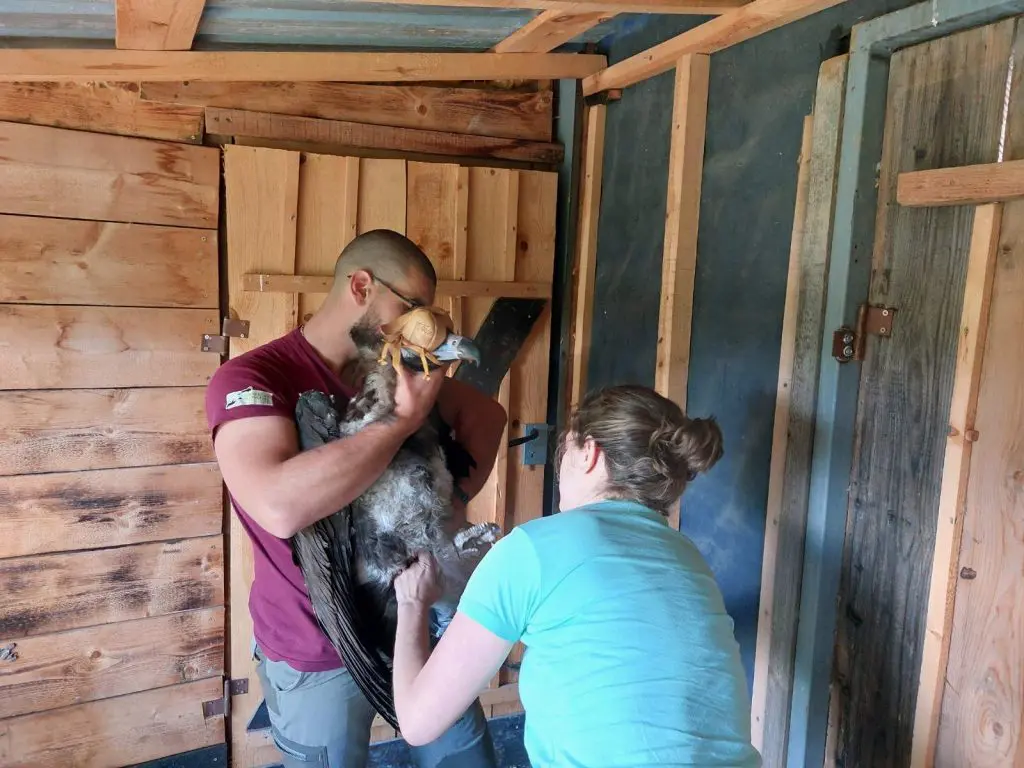
The cinereous vulture reintroduction project in France is a success story with the species now firmly re-established after going extinct in the country. Running since 2004, the reintroduction project in southern France moves closer to reaching the target of releasing 50 birds with the release of five more birds in the Grand Canyon du Verdon.
From Spain to France

Last September we here at the Vulture Conservation Foundation in collaboration with our partners AMUS (Acción por el Mundo Salvaje), Vautours en Baronnies and LPO-PACA transported eight cinereous vultures generously donated by the Junta de Andalucía from Spain to France with the aim of reintroducing these birds in the Gorges du Verdon region. The population of cinereous vulture in Spain is increasing and now stands at 3,000 pairs, mostly in the south western regions of Extremadura and Andalusia. The birds were all of wild origin and had been in wildlife recovery centers in Andalusia after being picked up exhausted and weak. One extra bird also came from a wildlife rehabilitation center in the French Atlantic Pyrenees (Hegalaldia).
Releasing the birds

After making the journey from Andalucía to southern France last autumn the birds have spent time in aviaries near the release site, becoming acclimatised to their new home and encountering the wild population that often visit the site.
The birds now released are four females and one male, aged three and four years old. They have been named Doradille, Raiponce and Sabline, after plants endemic to the Grand Canyon du Verdon, and Léo and Léa named by the Foundation Léa Nature – Jardin Bio.
The birds left the aviary over 4 days after the hatch was opened: Sabline and Léa the first day, Raiponce the next day, while Leo and Doradille waited 4 days before leaving the aviary. The following days, they stayed in the area to master the local weather and discover their new territory.
Before being released the birds were fitted with solar powered GPS transmitters, weighing between 30g and 70g they will send the GPS position of the birds over the mobile communications network and can provide several thousands fixes per day. Two of the tags have been provided by us here at the Vulture Conservation Foundation funded by the MAVA Foundation.
This will help the team at LPO-PACA understand their movements, like the amazing movements of Bernardus back in 2015/16 traveling back to southern Spain and returning to France. This data will also help understand the birds’ foraging ranges and habits, it also allows the team to pick up when a vulture is no longer moving and potentially injured.
In order to recognise them in flight, these birds have one or two discoloured white feathers contrasting with the black plumage.

Now released, the five birds are part of a population of 36 birds released in the Gorges du Verdon since 2005 and around 45 birds that have been released in the Baronnies since the project began in 2004.
Guide to spotting the silhouettes of the five released cinereous vultures (French) VM Verdon novembre 2018.pdf Adobe Acrobat Document 589.4 KB Download
A full list of the released birds in the Gorges du Verdon can be found on the LPO PACA cinereous vulture reintrodcuction website.
Breeding results

Verdon’s only breeding pair are Jean (a captive-bred male from Planckendael Zoo in Belgium) and Exo1 who successfully raised the region’s first wildborn cinereous vulture in 150 years in 2013. In this year´s breeding season they once again bred successfully, with their young fledging the nest in late September, and they were joined by relesed bird Girolle and Précoce (wildborn in the Baronnies in 2013), who in 2016 had already formed a pair and built a nest. Their chick hatched in May but unfortunately the breeding failed in June possibly due to the inexperience of the young pair and also the heavy spring rains. Hopefully they can have a more successful season next year. The behaviour of other pairs observed this year, Alcyone (male released in the Verdon in 2007) and Alambic (female, born in the Baronnies in 2014), and Voltige (female released in the Verdon in 2016) and Anjou (male released in Baronnies in 2010) brings hope that next year they will also begin breeding.
Results of the 2018 breeding season for vultures in Verdon (French) 2018 breeding season resuts for vultures Adobe Acrobat Document 238.2 KB Download
Cinereous vultures in France
Cinereous vultures went extinct in France more than 100 years ago, but a reintroduction project started in the early 90s in the Grands Causses. 53 individuals were released at the Grands Causses Regional Natural Park between 1992 and 2004, birds that were from the wild that were rescued at rehabilitation centres in Spain and also captive breed. Following the success of this project, in 2004 a second reintroduction project began at two other release sites, in the southern Alps in the Regional Natural Parks of Baronnies provençales and Gorges du Verdon. The objectives of these reintroduction programmes is to release 50 birds per site to create viable populations. To date 36 birds have been released at Gorge du Verdon and 45 at Baronnies. During an annual census in 2018 more than 37 breeding pairs of Cinereous Vultures were counted a
t the three release sites in France, and the species has now been firmly re-established.






